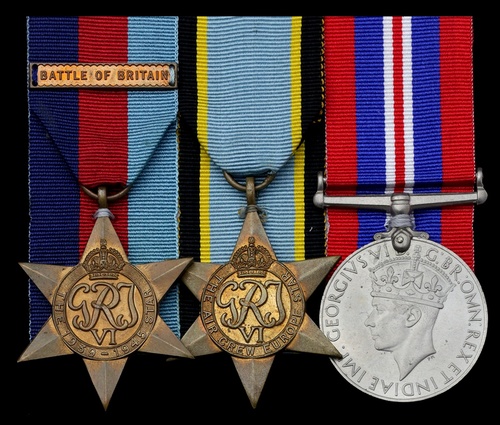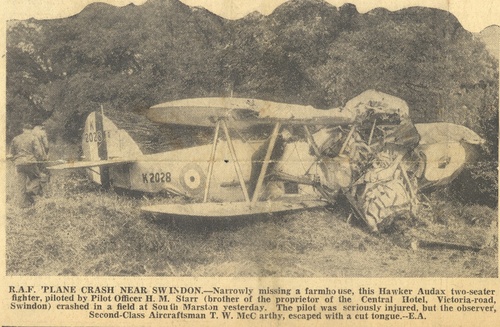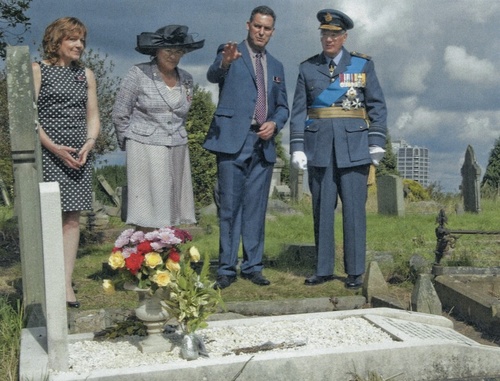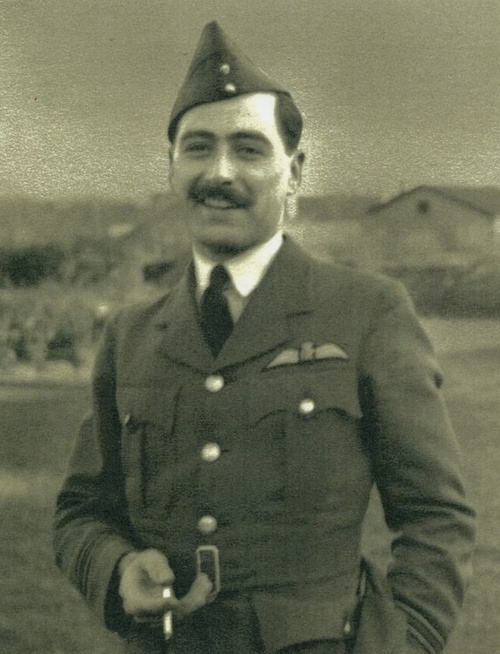Auction: 19003 - Orders, Decorations and Medals
Lot: 311
An outstanding 'Battle of Britain' Squadron C.O.'s campaign group of three awarded to Squadron Leader H. M. Starr, Royal Air Force, who assumed command of No. 253 Squadron on 8 August 1940 - he flew his first sortie in Hurricanes from Kenley on 28 August and was engaged in a hot scrap over Redhill, taking a 20mm cannon shell to his engine which forced his withdrawal
The very next day Starr 'lifted off' for the morning sortie and was shot down whilst engaging a large number of enemy aircraft who had their bombs set across sites in the southeast, he was shot down and forced to call upon his trusty parachute to save his life; floating over the 'Garden of England' it seems disgraceful that a trio of Me109's rounded on the helpless C.O. and machine-gunned him to death, leaving behind a heartbroken widow and an unborn child - this was just the second occasion such barbaric tactics had been employed by the enemy
Such were the casualties during the Battle, command devolved upon one Squadron Leader T. P. 'Tom' Gleave for the second sortie of the day, who himself was shot down and badly burned; Gleave became the first Airman to go under the knife of Sir Archibald McIndoe and No. 253 was left with its third C.O. in less than 12 hours
1939-45 Star, clasp, Battle of Britain; Air Crew Europe Star; War Medal 1939-45 Star, nearly extremely fine (3)
Harold Morley Starr was born at Swindon on 8 September 1941, the fifth of six children of Morley and Ellen Starr. Brought up in the Central Temperance Hotel where his mother was the proprietor, young Harold was educated at Clarence Street School and Cotham Grammar, Bristol. Having entered the Royal Air Force on a Scholarship in March 1934, he attended 5 Flying Training School, Sealand and consequently earned his 'wings'. He joined No.14 Squadron in March 1935 and was confirmed as Pilot Officer on 16 March. It was a little over a year before his first mishap in June 1936, while flying Audax K2028 with Airman 2nd Class T. W. McCarthy as his observer. Having the misfortune to suffer an engine failure, Starr used all his skill in bringing down the kite and 'narrowly missing a farmhouse, crashing in a field at South Marston'. While McCarthy walked away with a cut tongue, Starr suffered multiple serious injuries, including a fractured skull, leg and chest which kept him off duties until 28 June 1937. Having recovered in hospital he re-joined No. 59 Squadron at Old Sarum, before a number of postings to Hawkinge, which included promotion to Flight Lieutenant. By the outbreak of the Second World War Starr was recalled from a Staff posting and was promoted Squadron Leader. He had also married Bette Rees at Wrexham at the start of 1940.
Battle of Britain - 3 CO's in a day
Having been posted to 6 Operational Training School, Sutton Bridge on 1 July, Starr had been trained to operate Hurricanes and assumed command of No. 245 Squadron at Aldergrove on 21 July. This was only to be a short stay, for he assumed command of No. 253 Squadron at Turnhouse on 8 August. His predecessor was the legendary and laconic Squadron Leader T. P. 'Tom' Gleave, whom himself had requested the transfer back to Fighter Command to see action. Gleave would of course later go on to become the 'Chief Guinea Pig', but more of that to follow.
Gleave was told to remain with Starr and No. 253 until he was called upon and as such the pair would no doubt have been thrilled at the opportunities that would present themselves upon the move to Kenley on 29 August. Their first operational sortie of the battle was flown the very next morning, with 'wheels up' for the entire complement at 1130hrs. An hour later they had lost three killed in action. Starr had been lucky to come out of a scrape over Redhill, while piloting P2960, with his Hurricane being hit in the engine by a 20mm cannon shell. He returned to base, unhurt.
Little respite was possible at such a time and the next sortie for Starr was flown the very next day, having taken off at 0825hrs. The day had dawned fair but hazy and five waves, each containing 50 enemy aircraft piled in to bomb Britain through Deal, Dover and the Thames Estuary. Starr answered the call in L1830 but found himself having his aircraft shot up, thus he took to the parachute to save his life. His trusty Hurricane came to earth at Dene Farm, West Stourmouth.
Descending over the Garden of England from 15,000ft on his parachute, he must have seen the dogfights above him but would have hoped for a soft landing and a good pint in a local pub. The worst he might have expected would have been a broken ankle and a dusty uniform. A truly distasteful event followed, as seen by Mr H. G. Bennett, a gardener at Eastry House:
'I was working and used to start at 7.00am, worked until 8.00am and then returned home for my breakfast, and resumed working at 8.30am. It was as I returned to work that morning that I saw a parachute coming down over the Hammill Brickworks. As most of the dog-fights took place at some altitude, I didn't hear or see the aircraft, but as the parachute came drifting down, I saw quite a number of enemy aircraft circling. Suddenly one of the Messerschmitts dived towards the pilot on the parachute, and then the rest also piled in - I could hear the sound of machine-gunning.'
A local newspaper reported his death under the title 'Victim of Nazi Barbarity' and confirmed his death as only the second occasion of which such underhand tactics had been employed by the enemy on our Pilots. His body was recovered and returned to his family in Swindon for burial at Radnor Street Cemetery on 6 September, just two days before what would have been his 25th birthday. He left a heartbroken widow and an unborn child. The family, knowing the wishes of the gallant Squadron Leader requested no flowers at the wedding, instead asking for donations to be made to the Spitfire Fund.
As a result of his death on the Squadron's first flight of the day, Gleave was left to assume command for the afternoon sortie. He was unlucky himself, being shot down and badly burnt. Taken to Orpington Hospital for initial treatment, he was met by his wife who asked those famous words:
'What on earth have you been doing with yourself?'
Gleave quipped:
'I had a row with a German.'
Those words sum up the enduring spirit of the Fighter Pilot. Gleave was forwarded to the Queen Victoria Hospital, East Grinstead and was the first under the knife of the pioneering Surgeon Sir Archibald McIndoe. He became the 'Chief Guinea Pig' of that legendary band of brothers.
With Gleave's injuries, command of No. 253 devolved upon senior Flight Lieutenant W. P. Cambridge, the third Commanding Officer of that fateful day. Cambridge would lose his life just a week later.
Celebrated and commemorated
The memory of Starr has certainly not faded over the years. His name is written into the history of the Battle of Britain as it deserves to be: it is upon the Battle of Britain Memorial and his grave was adopted in the care of Robert Gurney during the year 1978. Gurney, a fireman at RAF Lyneham, took it upon himself to tend and maintain the memory of Starr. The Swindon Evening Advertiser quoted the following near Remembrance Day 1990:
'I feel as though I know him. I don't glorify war, but they were there and they did what they had to do. Our lads down in the Gulf would do the same if required. It could be because of his generation that we are here today.'
His Hurricane was excavated by the Kent Battle of Britain Museum in 1976, with the engine now proudly on display in the Stuart-Butte Memorial Hangar.
Starr is further commemorated by a blue plaque in Swindon with one also in memory of his brother, Wing Commander Starr, D.F.C. and Bar who was killed whilst flying an Anson home to get married.
On the 75th Anniversary of the Battle of Britain, the Duke of Gloucester was on duty to lay a wreath at the War Memorial, later visiting Starr's grave to pay his respects and later unveiling the First Great Western High Speed Train named in his honour. The locomotive which runs on the mainline carries his name, with the Squadron crest above it and the words 'One of the Few' below it.
Sold together with a comprehensive original archive comprising:
(i)
The Second World War Memorial Scroll, in the name of 'Squadron Leader H. M. Starr, Royal Air Force'
(ii)
The Battle of Britain "The Few" album, as issued to his family, dedicated to 'Squadron Leader Harold M. Starr. No's 245 & 253 Squadrons (Hurricanes) Killed 31st. August, 1940'. The inner page with label of 'Wg. Cdr. H. K. Rees, Spindrift, Rhosneigor, Anglesey.' - a descendant of Bette.
(iii)
His Royal Air Force 'wings', with backing and traces of having been removed from a tunic.
(iv)
An original, believed unpublished, portrait photograph.
(v)
A number of original related newspaper cuttings.
Subject to 20% VAT on Buyer’s Premium. For more information please view Terms and Conditions for Buyers.
Sold for
£4,800
Starting price
£3200
Sale 19003 Notices
Another group attributed to Starr is housed in the Kent Battle of Britain Museum.











